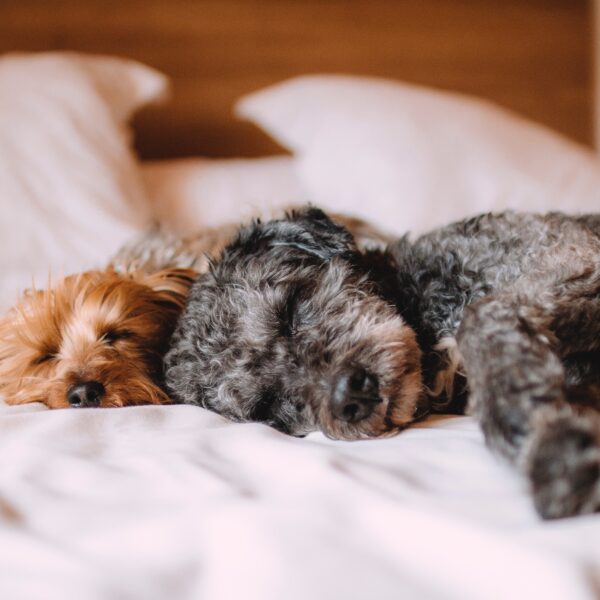As we slowly get back to our daily routines, it seems that the past year (and a bit) that we all stayed at home is finally coming to an end. And while most of us will be happy to get back to more normality, there is one particular family member who will likely be less than pleased that lockdown life may be over… 🐶 Most pups will have loved the past year as they’ll have had more time than ever with their beloved hoomins. But many dogs may struggle returning to (or beginning) a lifestyle where they spend more time home alone and some dogs may even develop separation anxiety.
In this article we explain how you can tell if your mutt is feeling lonely or anxious as you venture back to the outside world, and we’ll also be providing tips on how you can keep them feeling happy and secure- even when you can’t be with them.
What is dog separation anxiety?
Separation anxiety describes a behavioural condition where a dog becomes overly stressed and worried when they’re apart from their owners. The condition normally occurs when owners have to leave their dog at home alone, but it can also happen at night or any other time when you can’t be with your pup.

Dog anxiety symptoms
This really depends on each individual and there are many ways that separation anxiety can be displayed by your pet.
Some of the most common symptoms include:
- Destructive behaviours
- Weeing or pooing in the house
- Howling, whimpering or barking
And there are also some less frequent signs:
- Drooling excessively
- Trembling, pacing and/or whining
- Repetitive behaviour
- Nausea/vomiting
- Injuring themselves e.g. by excessively licking or biting part of their body
However, it’s worth noting that if you see any of these signs, it doesn’t necessarily mean that your dog has separation anxiety, as dogs with other behavioural problems- or even non-behavioural conditions- can also show one or more of these signs, and the diagnosis of a behavioural disorder such as separation anxiety will require a clinical exam by a vet.
So, if you do see your dog showing behavioural signs that you’re concerned about, it’s always best to speak to your vet, as they’ll be able to suggest the best course of action based on your pet’s behaviour. They may also refer you to a canine behavioural specialist for further support.
Identifying if your dog has separation anxiety
Because separation anxiety occurs when a dog is away from their owner, the condition can sometimes be difficult for owners to identify.
If your dog is destructive as a symptom of separation anxiety, these behaviours can be easier to spot- as owners can easily notice a torn-up pillow or chewed shoes when they arrive back home. Similarly, if your dog toilets while you’re out or displays self-traumatic behaviours such as licking their paws until they’re red and sore- this is also something owners tend to spot.
However, if you think you dog may be displaying signs of separation anxiety when you’re out that are more difficult to identify- for instance barking excessively or pacing- it’s a good idea to try to film them with a smartphone or video camera to see if you’re able to see any unusual behaviours.
It’s also useful to closely monitor your dog’s behaviours before and after you leave them. Are they becoming agitated or overexcited when you’re about to go out? Do they keep trying to follow you or start panting or pacing excessively? Or do they starting to show some of the separation anxiety symptoms listed above? Even if these behaviours appear to be milder while you’re at home, they’re worth being aware of as they may become more pronounced when you leave.

Dog anxiety help
So, what can you do if your dog has anxiety when left alone? First and foremost, it’s important to get in contact with your vet. They’ll be able to ask you further questions to help to determine whether or not your dog may be suffering from separation anxiety, and they’ll also be able to discuss treatment options with you. And they may also put you in touch with a veterinary behaviourist- a vet who has a special interest in behaviour and will have had extra training in this area.
As well as speaking to your vet, there are also some things you can do at home to try and help with your dog’s separation anxiety:
Counterconditioning: this is where you teach your dog to associated negative things e.g. being left alone, with something positive. The aim of this technique is for your dog to learn that a situation they fear can often mean good things for them. One example of how you can try this technique at home is by leaving lots of pet-safe toys out for you pup when you have to leave them on their own, as these not only act as a distraction, but will also make them associate you leaving them with more positive, happy emotions.
More advanced desensitisation: this is a more complex counterconditioning technique that can be a bit trickier to carry out- so it’s always best to speak to your vet before trialling it. The reason why this technique can be a bit more complicated is because the treatment has to progress slowly depending on your dog’s reactions- and these subtle behaviours can be difficult to read. However, to give you a rough idea of how this treatment technique works, here’s the process broken down into steps:
- Predeparture cues: if your dog starts to show anxious behaviours before you leave, it may be because they are predicting your departure based on your actions- e.g. if you pick up keys or put on your coat or shoes. One way to try and avoid this is to teach your dog that these behaviours don’t always indicate you’re going out. And you can do this by picking up your keys and then sitting down and then watching TV or putting on your shoes before sitting down to eat dinner.
- Graduated departures/absences: plan for the time you are absent to be shorter than the time it takes for your dog to become worked-up or anxious. You can start by just standing in another room behind the door and telling your dog to stay, and then slowly increase how long you leave your dog alone for and how far you go e.g. gradually progressing to walking to the shops or visiting a friend. This will help your dog to get used to you leaving them and will also build their tolerance to this.
How long to leave your dog alone
This will very much depend on the individual. If your dog suffers from separation anxiety, it’s always worth speaking to a veterinary professional about how long your dog should be left, as they may suggest a behavioural treatment protocol which involves your dog being left for very specific time periods.
That being said, when it comes to dogs without any known behavioural issues, puppies should be left alone for no more than two hours, and adult dogs should ideally not be left alone for more than six hours. But always consider that these time frames aren’t set in stone and will still depend on many factors such as age, health conditions, breed and individual personalities.


